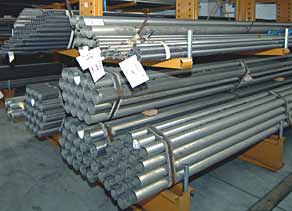Characteristics of heat-resistant steels
Heat-resistant steels can be described as steels with good mechanical properties under short-term and long-term stress, additionally characterised by a special resistance to the effect of hot gas combustion products like salt and metal baths at temperatures above 550°C. However, their resistance is very much dependent on chemical attack conditions, and therefore cannot be exactly measured with a single testing procedure.

Heat-resistant or cinder-resistant steels are composed in such a way that the produced cinder makes diffusion of the alloying elements in the oxide coating more difficult, thus protecting steel from further warm scaling. This is mainly obtained through the chrome alloying element oxides. Silicon and aluminium also increase resistance to cinder. There are two main categories of steel: ferrite and austenitic steels. Ferrite and ferrite-austenitic steels are magnetisable, while mere austenitic steels are not.
Ferritic steels
Their main chrome element produces a conversion-free ferrite structure. Their resistance to cinder is still increased through silicon and aluminium alloying, both of which also have a ferrite-forming effect.
They are highly resistant to sulphurous gases, yet show lower creep-rupture strength as compared to heat-resistant austenitic steels at higher temperatures.
Signs of embrittlement appear at specific temperature ranges. Embrittlement especially occurs after cooling down to room temperature, which is why shock-stress is to be avoided, like e.g. when carrying out repairs.
Austenitic steels
Steels of this type have a conversion-free austenitic structure and are characterised by heat-resistance and toughness.
Their tendency to embrittle is much lower than ferrite steels.
It partly does not occur at all only after a long period of time or after exceeding a minimum temperature.
The cinder-resistance in oxidising atmosphere is very high; these steels are sensitive to reducing sulphurous gases. They have good cold-forming properties and can be welded using almost all procedures.
Nickel steels
These materials show a high resistance to corrosion, erosion, and cavitation. The highly heat-resistant alloys are hot-gas corrosion-resistant and can be used up to 1150°C. The nickel alloys are used in heat-technical procedures and in power plant and machine construction. The high nickel contents make alloys especially sensitive to sulphurous gases in a non-oxidising atmosphere. Pipes in this material show no signs of embrittlement, have good heat-resistant properties at high temperatures, and can also withstand heavy mechanical stress. Heat-resistant nickel alloys can be welded according to all conventional procedures.
